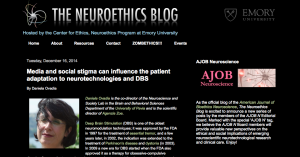The effect of media and social stigma on neurotechnolgies: an invited commentary

Tuesday, December 16, 2014
Media and social stigma can influence the patient adaptation to neurotechnologies and DBS
 Daniela Ovadia is the co-director of the Neuroscience and Society Lab in the Brain and Behavioral Sciences Department of the University of Pavia and is the scientific director of Agenzia Zoe.
Daniela Ovadia is the co-director of the Neuroscience and Society Lab in the Brain and Behavioral Sciences Department of the University of Pavia and is the scientific director of Agenzia Zoe.
Deep Brain Stimulation (DBS) is one of the oldest neuromodulation techniques; it was approved by the FDA in 1997 for the treatment of <a href="http://www navigate to this web-site.ncbi.nlm.nih.gov/pubmedhealth/PMH0001768/” onclick=”_gaq.push([‘_trackEvent’, ‘outbound-article’, ‘http://www.ncbi.nlm.nih.gov/pubmedhealth/PMH0001768/’, ‘essential tremor’]);” >essential tremor, and a few years later, in 2002, the indication was extended to the treatment of Parkinson’s disease and dystonia (in 2003). In 2009 a new era for DBS started when the FDA also approved it as a therapy for obsessive-compulsive disorder. Some patients experienced a very good outcome, while others were less lucky and experienced side effects such as cognitive, behavioral or psychosocial impairments. DBS is now a common procedure for the treatment of many motor and behavioral impairments.